Adora Cheung (2nd part of the lecture): growth hacking
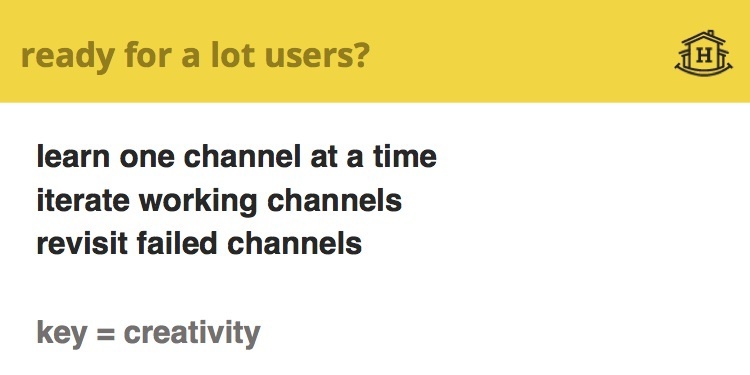
Stanford course CS183B: How to start a startup . Started in 2012 under the leadership of Peter Thiel. In the fall of 2014, a new series of lectures by leading entrepreneurs and Y Combinator experts took place:
Second part of the course
First part of the course
- Sam Altman and Dustin Moskovitz: How and why to create a startup?
- Sam Altman: How to form a startup team and culture?
- Paul Graham: Illogical startup ;
- Adora Cheung: Product and Honesty Curve ;
- Adora Cheung: The rapid growth of a startup ;
- Peter Thiel: Competition - the lot of losers ;
- Peter Thiel: How to build a monopoly?
- Alex Schulz: Introduction to growth hacking [ 1 , 2 , 3 ];
- Kevin Hale: Subtleties in working with user experience [ 1 , 2 ];
- Stanley Tang and Walker Williams: Start small ;
- Justin Kahn: How to work with specialized media?
- Andressen, Conway and Conrad: What an investor needs ;
- Andressen, Conway and Conrad: Seed investment ;
- Andressen, Conway and Conrad: How to work with an investor ;
- Brian Cesky and Alfred Lin: What is the secret of company culture?
- Ben Silberman and the Collison Brothers: Nontrivial aspects of teamwork [ 1 , 2 ];
- Aaron Levy: Developing B2B Products ;
- Reed Hoffman: On Leadership and Managers ;
- Reed Hoffman: On the leaders and their qualities ;
- Keith Rabois: Project Management ;
- Kit Rabois: Startup Development ;
- Ben Horowitz: Dismissal, promotion and reassignment ;
- Ben Horowitz: Career advice, westing and options ;
- Emmett Shire: How to conduct interviews with users;
- Emmett Shire: How to talk to users in Twitch ;
- Hossein Rahman: How hardware products are designed in Jawbone;
- Hossein Rahman: The Design Process at Jawbone.
So let's say that you have a product that can attract many users. What do you need to do now? The next few of my slides will be about different types of company growth, but it’s very important to begin with that: at a very early stage, when only you, your co-founder and a couple more people are in the project, you don’t need to create a team just for the sake of growth . First of all, you yourself must do everything you need - you need to focus, because you will definitely want to try using several strategies at the same time.
')
In fact, you will need to focus on one channel and work only with it for a week. And if the chosen approach works, continue using it until it is “worked out” to the end. If the chosen approach does not work, go to the next option. So you will have more confidence that the channel you are working with does not really suit you, and your primary hypothesis is wrong than if you spent a third of all time on this channel / hypothesis for several weeks. So study the possibilities of only one channel per unit of time.
Secondly, working with one single channel and searching for suitable strategies within this channel, always act iteratively. You can even create a system of rules and pass the work on this process to someone else, but remember that these channels are constantly changing. Everything from advertising on Facebook and Google to distribution channels, the whole environment that you do not control changes over time, and you should always be ready to continue iterative work with these channels and optimize your actions for them. And finally, as soon as you understand that the selected channel does not work as it should, immediately switch to another - there are many options. However, after some time you can go back to this channel and try again to work with it.
Example
When we first created Homejoy, we didn’t have the means - so when we tried to buy ads on Google to attract customers, we quickly realized that large companies have a lot of money and they earn much more than ours. This means that they could attract users for much more money. So we could not afford it, and we had to switch to another channel. But now we are earning a lot more, and in many things we have made significant progress compared with the first steps in business. Therefore, we may return to the idea of buying Google ads. That is what I mean.
The key to everything is your creativity. Marketing or development as a whole may seem to be purely technical processes, the way it is, but you need to be creative with them, because if everything was really so simple and clear, everyone would create frantically growing companies. Therefore, you always need to look for something that no one else is doing, and to work in these areas to the maximum.

There are three types of growth:
- Sticky growth [so-called “Growth due to user retention”], viral growth and paid attraction of new consumers. Growth due to user retention is based on the fact that your existing users return to you and pay more or use your product more intensively.
- Viral growth is related to the fact that people start telling others about you. You use the product, you like it, you tell ten friends about it, they like it too - this is how viral growth works.
- The third type of growth is paid user attraction. If you have enough money, you can use part of it to ensure the growth of your audience with cash injections.
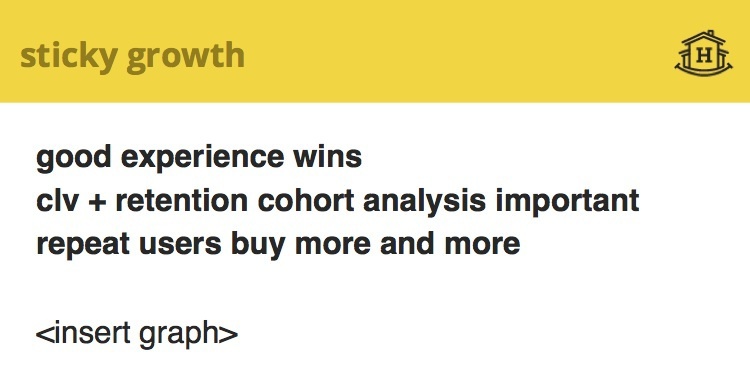
The central theme that I want to talk about in this regard is sustainability. Sustainable growth means that your business is not a “leaky bucket”, that your investment in it pays off.
So the growth at the expense of the existing audience, as I already said, is in an attempt to get those who used your product to come back and buy it again. In this case, the most important thing is to provide a quality user experience, right? You create a cool UX, and users want to continue working with your product.
In order to measure this indicator, assess the situation and understand how you provide such repeated attraction of users with your work, you need to measure the CLV indicator [Customer Lifetime Value, the company's total profit per customer for all the time you cooperate with it] and use the cohort analysis.
CLV, some call this indicator TLV [Total Lifetime Value] - this is all the time you work with a client. In essence, this is the net profit that the user brings to the company, for all the time of their interaction with you. Therefore, the CLV value for 12 months shows the amount of net revenue [net of taxes and refunds] that a customer brings to you within 12 months. Sometimes this figure is considered one month or six months. Now about the cohorts: the graph [below] will reflect the time and percentage of users who came to you again. At the zero point, this figure will be equal to 100%.
The cohort is another name for the user segment. You can study cohorts of male and female users or compare users from Atlanta, Georgia with clients from Sacramento, California. The most common period in which the comparison takes place is equal to a month. So the cohort is a month. Let us, for simplicity of experiment, say that we are interested in March 2012. So, in March 2012 your product is used by 100% of your customers. Then, in a month, perhaps, only 50% of those who bought your product will come back to you again. And who will be back in two months? This indicator may decrease even more. Therefore, over time, you will get a curve that looks like this:
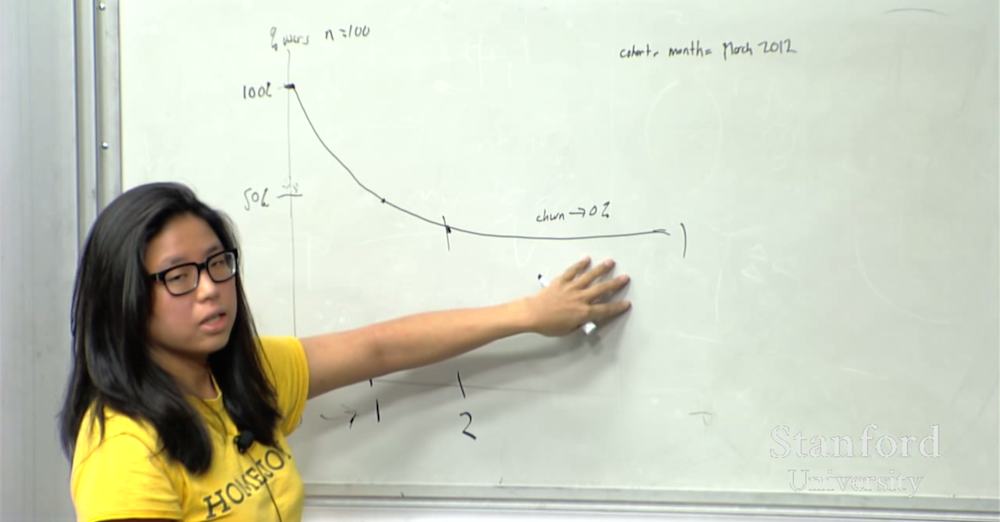
Some users will always go away. The reason that customers do not return after the first purchase may be that they found the product not worth the money you are asking for it, or, for example, got a negative impression of use. You want your curve to become straight, even out over time - these remaining users will create the core of your audience, those who stay with you for a long time.
Now suppose a year has passed and you have done a lot. You draw the same graph and hope that the curve will look like this:

This means that even in the first period, 50% of the initial volume of customers remained with you, and now more and more people are “attached” to your product. The retention curve, which does not bode well, looks like this:

This suggests that after trying your product for the first time, customers hated you so much that no one came back. I do not know what kind of business this may be, probably something very bad. A good business simply cannot have such a user retention curve. Over time, you will think about strategies that would help your curve go up, and to put these desires into practice, you need to continue to analyze your indicators in order to determine how the chosen strategy “works”.
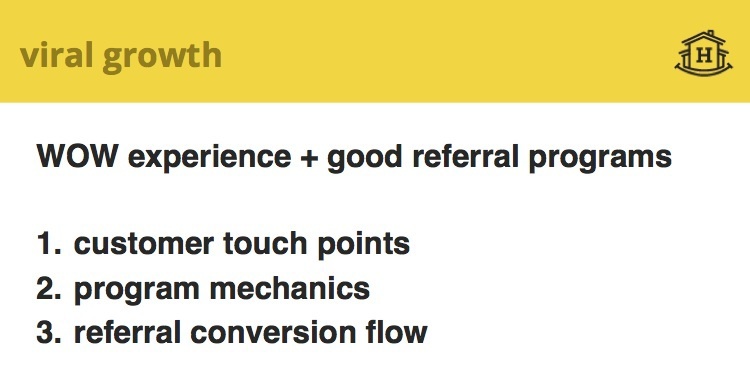
The next type of growth is viral. As in the previous version, you need to provide high-quality user experience. Moreover, you need to make them very, very cool. What will make people write enthusiastic reviews on Facebook and Twitter or somewhere else, tell friends about you or write letters to relatives? You need the user experience of working with your product to be really great. And with this, you need to create a very good referral program. You have 100 customers who want to talk about you - how will they do it?
So, in this sense, the strategy of viral growth is very closely connected with creating a positive user experience, but even if you implement it, how do you create a good referral program? I will list the main points.
First, you need to think about the points of contact with customers - how do people know that they can invite their friends to use your product? This is usually done after a product / service is booked or registered. It is best to offer something similar after a person has been working with the product for some time, and you realize that he is truly involved in this process - then you can ask him to share a link to your product with friends and acquaintances.
Homejoy Case Study
We, for example, come to our home customers. Therefore, another point of contact for us is when our professional cleaner comes to the client and does his job brilliantly - in this case we can also hope for a viral effect. You just need to calculate all possible points of contact with users and understand how they can spread information about you among friends at the time when they are actively involved in working with your product, and this product causes users to have extremely positive emotions.
The second point is the mechanics of your viral program. Most often, I see the system "10 bucks for 10 bucks." This means that you, as a user, receive $ 10 if you invite your friends to start using the product, and they in turn will receive $ 10. You need to try different types of mechanics and try to optimize those that will be the “workers” for you. It can be the system "25 for 25", "10 for 10", whatever. And finally, when your friend clicks on the link you sent him, and goes to the site, it is very important to optimize the conversion at the registration stage. Sometimes you have to sell the product to such users a little differently than everyone else, or do an “upsell” - telling the user that his friend suggested that he would use it and this and so on. Using all this, you will process your existing and potential users from different sides and create a good referral program.
And, finally, paid consumer attraction. Here are some examples of such growth:
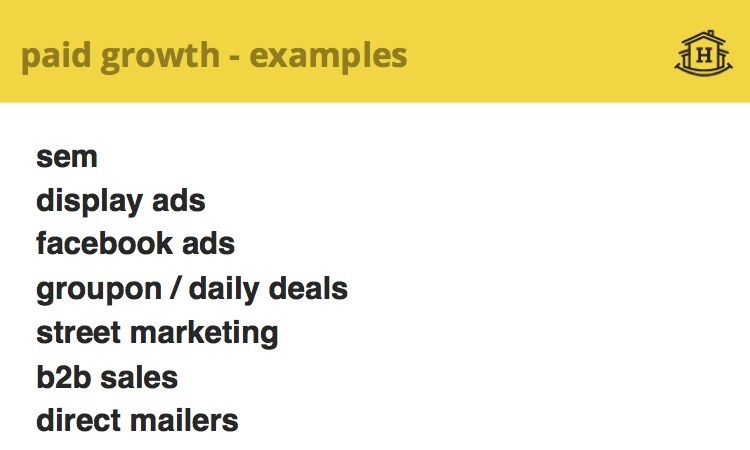
These are the most obvious options - I believe that you can easily remember more. Paid attraction of new users is made when you have money that you can spend on it. The correct attitude to this type of growth should be based on the understanding that you are risking money - and therefore must understand what the return on your investment will be.
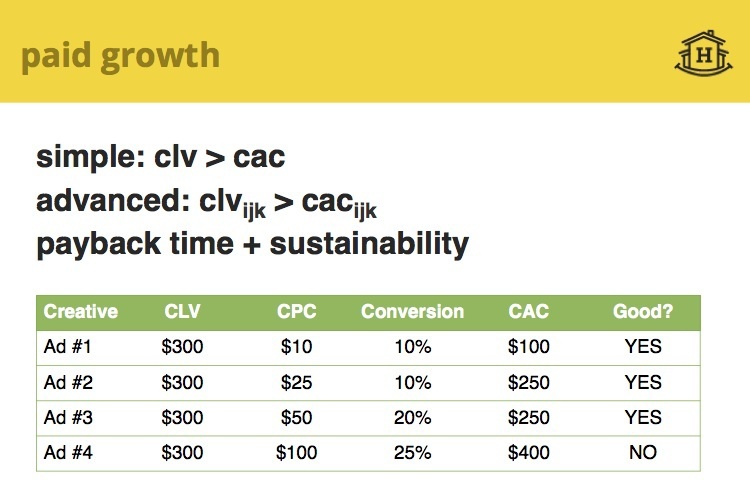
The easiest approach is to compare CLV and CAC. CAC is an abbreviation of Customer Acquisition Costs. Say, you launched an advertising campaign on the Internet that lasted 12 months, according to the results of which each attracted user brought you $ 300. For each of the different types of advertising, CPC [Cost Per Click, cost per click] will cost differently - after all, by clicking on an advertisement, the user will have to get to your site, and then register or make a purchase.
Conversion rates for all these ad impressions will vary. CAC is calculated as CPC divided by conversion. You see: for different types of advertising the price of attracting a user will be different.
To determine whether this or that type of advertising is beneficial to you or not, you need to calculate the difference between CLV and CAC. If the difference is greater than zero, you make a profit. You see: despite the fact that the CLV does not change, and the conversion rate rises and falls, some types of advertising, which at first glance seem to be a profitable investment, are in fact ineffective.
You can calculate the value of these indicators for your entire customer base as a whole, but it will be much more efficient to break all users into segments. If you create a marketplace for country-style music, the CLV value for a user from Nashville, Tennessee will be much higher than that for someone from Czechoslovakia [It's funny that Adora cites an example of a country that split before it turned ten years. Maybe this is done to show that in this example the CLV for a resident of Nashville will be definitely higher in any case]. I just assume that this may be so.
You want to make sure that when you buy advertising for different types of cohorts, you understand how these cohorts and types of advertising differ, so as not to confuse anything. The last important point related to payback and sustainability refers to the difficulties that arise when businesses start to spend beyond their means. This is very closely related to risk attitudes, how much you are willing to take risks.
So, suppose, according to the CLV indicator, a client for 12 months brought you $ 300.
In the first month, he provided you with a hundred dollars. During the year, the client brought you another $ 200. But if you initially invested in attracting $ 200, then you will find yourself at a loss until the end of the year, until the user brings you additional earnings.
At this time you find yourself in a state of unsustainable growth. After a year, something can happen that does not provide this $ 200 from the user, and you will find yourself in a very unpleasant situation. In essence, you just run out of money. And if you want to pay all these expenses with a credit card, you will probably be bankrupt very soon.
At this time you find yourself in a state of unsustainable growth. After a year, something can happen that does not provide this $ 200 from the user, and you will find yourself in a very unpleasant situation. In essence, you just run out of money. And if you want to pay all these expenses with a credit card, you will probably be bankrupt very soon.
So, business returns are extremely important. The safe period during which it is possible to work without return is three months. If you really like the risk - you can work at a loss for a year. But after 12 months of work in this mode, you go to a very unstable soil.
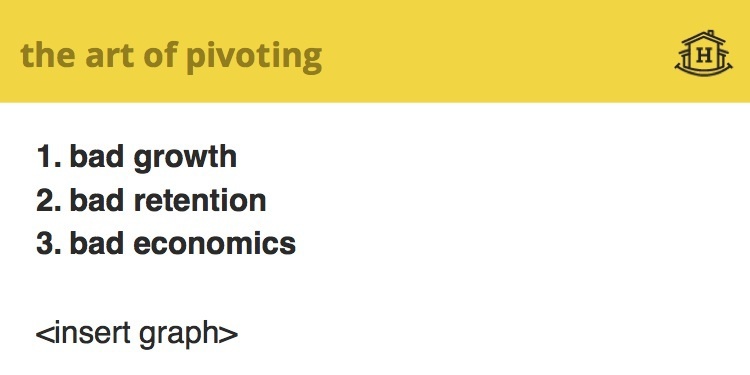
Now about the art of pivot - Homejoy in its current form - literally the 13th idea, which we completely designed, tried to realize and attract an audience to it. Therefore, I am often asked: “How did you even get to this 13th idea and decided to continue working?”.
The best advice I can give is to take a look at these three criteria. When you understand that growth stops, and despite all your improvements and attempts to attract users, none of them return again, or the business economy “does not converge” - once you realize all this, you must move on.
The most difficult thing is with growth, because there are so many stories about how the founders had an idea, how they had been doing something for three years, and then everything suddenly began to grow and develop wildly. What you really need is to create your growth plan at the very first stage of work.
What are optimistic (within reason) ways to grow your business? The plan should answer questions like this. In the first week you need only one user, in the second - two, and so on. And you must continue to double their number.
In the first week, you usually need to work on the product extremely intensively to attract your first user. And over the next week - do as much to attract the second. If you have a product that appeals to the audience, it will be easy for you to maintain this growth curve by finding potential customers on your own. That's when you add 100 users per week, you will need your growth strategies.
I often say that if you are completely immersed in your project, if you are working with full dedication, and for three or four weeks in a row you do not see any growth at all or even an outflow of customers, think about pivot.
Maybe you will not need to come up with a radically new idea - but this situation means that you are making some fundamental mistake, because in the early stages a startup must constantly grow. This is an optimistic version of how everything should look - I drew a similar kind of curve when I created Homejoy, but in reality everything turned out to be a little different.

So, you need to make sure that, even after a brief lull, you will not stop. This is what happens if you wait 2 or 3 weeks. Since you will continue to work seriously on the project, you will eventually return to this point, and a similar trend will repeat again over time.
Now I can answer your questions.
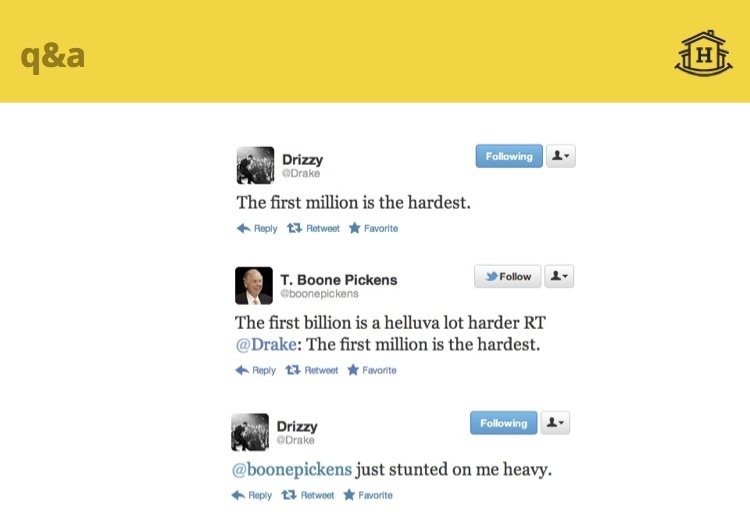
Q: If people are already working with a product that is convenient for them, how to lure them to their side?
Adora: There is always the cost of moving a client from one company to another. I’ll tell you about this using the example of Homejoy. We essentially created a new market in the sense that many of our original users never used cleaning services — so it was quite easy for us to attract them. But many of those to whom someone comes to get out, really trust these people.
Making them try something different is perhaps the most difficult task in the world. When you create a project and try to get people to switch to your product, you need to understand very well in which areas your product or service far exceeds the existing solutions that your audience already uses.
As an example: there are people to whom a cleaner comes regularly, but on some of the days they had a party, and the next day they need additional cleaning. Since Homejoy in most places allows you to order the service the next day, such customers may well contact us, because they know that their regular cleaner will not be able to come and work after hours.
And as soon as they begin to use our product, they gradually feel all those small advantages of working with it, which as a result form substantially greater benefits for the client. They understand that cash or check payments can be inconvenient for them, so they appreciate being able to pay everything online. The ability to cancel or move the cleaning in accordance with its own schedule, too, many seemed extremely useful.
Many people, creating a product, think: “Yes, I have 50 features that are much better than the capabilities of competitors” - but you need to understand that even if the benefits outweigh the cost of switching from one competitor to you, it’s very difficult to convince users and collect all the benefits come from a variety of small things. It is much better to have two or three pronounced differences that make your product unlike competing products.
Making them try something different is perhaps the most difficult task in the world. When you create a project and try to get people to switch to your product, you need to understand very well in which areas your product or service far exceeds the existing solutions that your audience already uses.
As an example: there are people to whom a cleaner comes regularly, but on some of the days they had a party, and the next day they need additional cleaning. Since Homejoy in most places allows you to order the service the next day, such customers may well contact us, because they know that their regular cleaner will not be able to come and work after hours.
And as soon as they begin to use our product, they gradually feel all those small advantages of working with it, which as a result form substantially greater benefits for the client. They understand that cash or check payments can be inconvenient for them, so they appreciate being able to pay everything online. The ability to cancel or move the cleaning in accordance with its own schedule, too, many seemed extremely useful.
Many people, creating a product, think: “Yes, I have 50 features that are much better than the capabilities of competitors” - but you need to understand that even if the benefits outweigh the cost of switching from one competitor to you, it’s very difficult to convince users and collect all the benefits come from a variety of small things. It is much better to have two or three pronounced differences that make your product unlike competing products.
[ Translation of the next lecture by Peter Thiel]
Source: https://habr.com/ru/post/244077/
All Articles